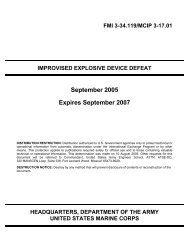AR 215-1 - Soldier Support Institute - U.S. Army
AR 215-1 - Soldier Support Institute - U.S. Army
AR 215-1 - Soldier Support Institute - U.S. Army
Create successful ePaper yourself
Turn your PDF publications into a flip-book with our unique Google optimized e-Paper software.
funds and other MWR funds on the garrison. This is accomplished through the MWR chief, financial management<br />
division (FMD) or equivalent and garrison (or centralized) CAO.<br />
c. All employees have fiduciary responsibility for properly using NAF and APF and preventing and reporting<br />
suspected waste, loss, or unauthorized use of NAFs (see chap 4, sec II).<br />
16–3. Successor-in-interest<br />
The successor-in-interest NAFI may provide financial support and assistance to specified or assigned NAFIs/entities, as<br />
required, and will assume all outstanding liabilities or receive the residual assets of NAFIs/entities following their<br />
dissolution.<br />
a. The IMCOM Region director, through the region single MWR fund, is the successor-in-interest to all Regionlevel<br />
NAFIs and to all garrison MWR operating entities within the IMCOM Region. When a Region single MWR fund<br />
does not exist or IMCOM Region resources are not adequate, the IMCOM Region director may cross-level funds<br />
within the IMCOM Region and among other IMCOM Regions with concurrence from the HQDA Commander,<br />
IMCOM.<br />
b. The ACWF is the successor-in-interest to all installation Civilian Post Restaurant Funds and Civilian Welfare<br />
Funds (see <strong>AR</strong> <strong>215</strong>–7).<br />
c. The Hospitality Management Fund is the successor-in-interest to Edelweiss Lodge and Resort, Dragon Hill<br />
Lodge, <strong>AR</strong>MP Operations, the Hale Koa Hotel, and AFRC–Orlando (Shades of Green) NAFIs.<br />
d. The AMWRF is the successor-in-interest to—<br />
(1) All IMCOM Region single MWR funds, only when all IMCOM Region single MWR funds are insolvent.<br />
(2) HQDA NAFIs, joint services or DOD NAFIs when specifically designated as executive agent by DOD issuance,<br />
and joint Services or DOD NAFIs established pursuant to <strong>Army</strong> policy where the AMWRF has been specifically<br />
designated as the successor-in-interest.<br />
Section II<br />
Cash Management<br />
16–4. Funding standards<br />
The DOD basic standard, regardless of category, is to use APFs to fund 100 percent of authorized expenditures. Total<br />
expenditures for measuring compliance with these standards will be computed by adding total APF support (both direct<br />
and indirect, not including military construction) to the total NAF support (total expenses less cost of goods sold and<br />
depreciation). To obtain APF support as a percent of total expenditures, the amount of APF support is divided by the<br />
total of APF support plus NAF support.<br />
a. Category A. Category A programs are entitled to the highest degree of APF support, and virtually all expenses<br />
should be supported with APFs. However, Category A programs at garrison level are frequently collocated with other<br />
minor functions (incidental resale/revenue producing activities) that are not authorized APF support. These functions<br />
are considered category C for funding purposes and should be reported in that category if their size is significant or<br />
they are not integral to program delivery. In many cases, their small size makes it impractical to break them out and<br />
report them separately from their parent category A program. For these reasons, the DOD APF standard for category A<br />
is a minimum of 85 percent of total expenditures.<br />
b. Category B. Category B programs also frequently include incidental resale/revenue-producing activities integral to<br />
the category B program. As in category A, these functions are considered category C for funding purposes and should<br />
be reported in that category if their size is significant or they are not integral to program delivery. The DOD standard<br />
for APF funding is a minimum of 65 percent of the total expenditures.<br />
c. Category C. APF support to category C is limited to that support specified in appendix D.<br />
16–5. Total cash management<br />
All <strong>Army</strong> NAFIs (includes supplemental mission NAFIs) and garrison MWR operating entities are required to generate<br />
sufficient cash and a positive net income before depreciation of at least the minimum level established by the MWR<br />
BOD which, when coupled with existing funds, will permit the NAFI/entity to fund all of its own requirements, both<br />
operating and capital, with the exception of NAF major construction funded by the AMWRF. Long-term requirements<br />
must be fully covered by adequate cash flow. Each NAFI/entity must produce adequate revenues to cover operating<br />
and capital requirements over the short and long term while maintaining a cash-to-debt ratio between 1:1 and 2:1.<br />
16–6. <strong>Army</strong> simplified dividend distribution<br />
Garrison MWR funds will receive locally generated income from AAFES operated package beverage stores and<br />
telephone contract profits as earned, plus a percentage of AAFES revenue generated on the installation. IMCOM<br />
Regions and garrisons will be notified in writing annually of the projected percentage for revenue sharing with AAFES.<br />
The IMCOM Regions will determine how the monthly ASD distribution is allocated to their garrisons.<br />
120 <strong>AR</strong> <strong>215</strong>–1 • 31 July 2007

















